The sight of a Great Blue Heron lifting off the ground and soaring over a body of water is nothing less than majestic!
These tall, long-necked birds are year-round residents of much of the United States. They can also be found in Canada during their breeding season and in Mexico during the winter.
Great Blue Herons are beautiful, graceful, and peaceful birds that evoke a feeling of calm and serenity–unless, of course, it’s breeding season.
During the breeding season, Great Blue Herons shriek and squawk for up to 20 seconds at a time, creating quite a commotion.
Even though they are recognizable, there are a number of bird species that look similar to the gorgeous, long-legged heron. Similar birds may have a comparable shape, color pattern, or silhouette.
Often, these birds are spotted from a distance, which means there is more room for misidentification.
When identifying one of these large, coastline-dwelling birds, it can be helpful to know the differences between herons, egrets, and cranes.
Identifying a Great Blue Heron
Great Blue Herons are the largest herons in North America. They stand about 4 feet tall and have a wingspan between 6 and 7 feet across. When flying, their wings and chest look give them a “shaggy” appearance.
The bird’s long neck can stretch or be contracted into a curved “s.” Both males and females have the same general appearance, with males weighing in a bit heavier than females. Males are usually about 54 inches long, whereas females are more like 38 inches long.
Great Blue Herons are grayish-blue in color. Over each eye, they have a black stripe.
Great Blue Heron Habitat
Great Blue Herons live along the water’s edge. That includes sources of freshwater and saltwater. You will find them in marshes and wetlands as they do along riverbanks and ocean coasts.
Herons are quite adaptable when it comes to their habitats. They prefer to nest in trees, but they can also build nests on the ground or in bushes.
They will often build their nests in platforms built by humans, such as channel markers, platforms, or other structures.
Is There More Than Just One Kind of Heron?
Herons are part of the Ardeidae family, which is a subcategory of the order Pelecaniformes.
Members of the Ardeidae family live along the water and are known for being wading birds. Their long legs allow them to wade into the water. Their diet consists of aquatic animals, including fish, crustaceans, and amphibians.
This family includes herons, egrets, and bitterns.
There are several different kinds of herons. We will look at this in more detail in this article.
Types of herons and where they are most likely to be found:
- Black Crowned Night Heron (North America and South America)
- Black Heron (Africa)
- Gray Heron (Europe, Asia, and Africa)
- Great Blue Heron (North America)
- Green Heron (North America, Central America, and South America)
- Great White Heron (Atlantic and Gulf Coast of North America and Caribbean islands)
- Goliath Heron (Africa and South Asia)
- Little Blue heron (North America)
- Malayan Night Heron (South Asia and Southeast Asia)
- Pacific Reef Heron (Pacific Islands)
- Striated Heron (South America, Asia, Africa, Oceania)
- Tri-colored Heron (Atlantic and Gulf Coast of North America)
- Yellow-Crowned Night Heron (North America and Central America)
What Is the Difference Between an Egret and a Heron?
Egrets and herons are both parts of the Ardeidae family.
Egrets are smaller than herons and are not as colorful as their heron cousins. In fact, egrets are always white, whereas herons can be blue, gray, white, black, or other color combinations.
What Is the Difference Between a Crane and a Heron?
The crane family is called Gruidae and is part of the larger group Gruiformes. This means that cranes and herons, while similar in appearance, are not related.
Cranes and herons have long necks, but herons’ necks have that distinctive “s” shape, and cranes do not. Cranes have smaller heads and fly with outstretched necks.
In flight, herons beat their wings slowly. They almost never raise their wings above a parallel line with the earth. Cranes, on the other hand, flap their wings rapidly and raise their wings high above the plane of their bodies as they fly.
Birds That Look Like Great Blue Herons
When you see a bird along the coastline, either wading or flying, do you know if it’s a Great Blue Heron or another similar-looking bird? Perhaps it’s a different type of heron, an egret, or even a crane.
This list of birds that look like herons will provide you with a useful overview of birds that have something in common with Great Blue Herons.
That may be their size, shape, silhouette, feather patterns, coloring, or something else altogether.
American Bittern
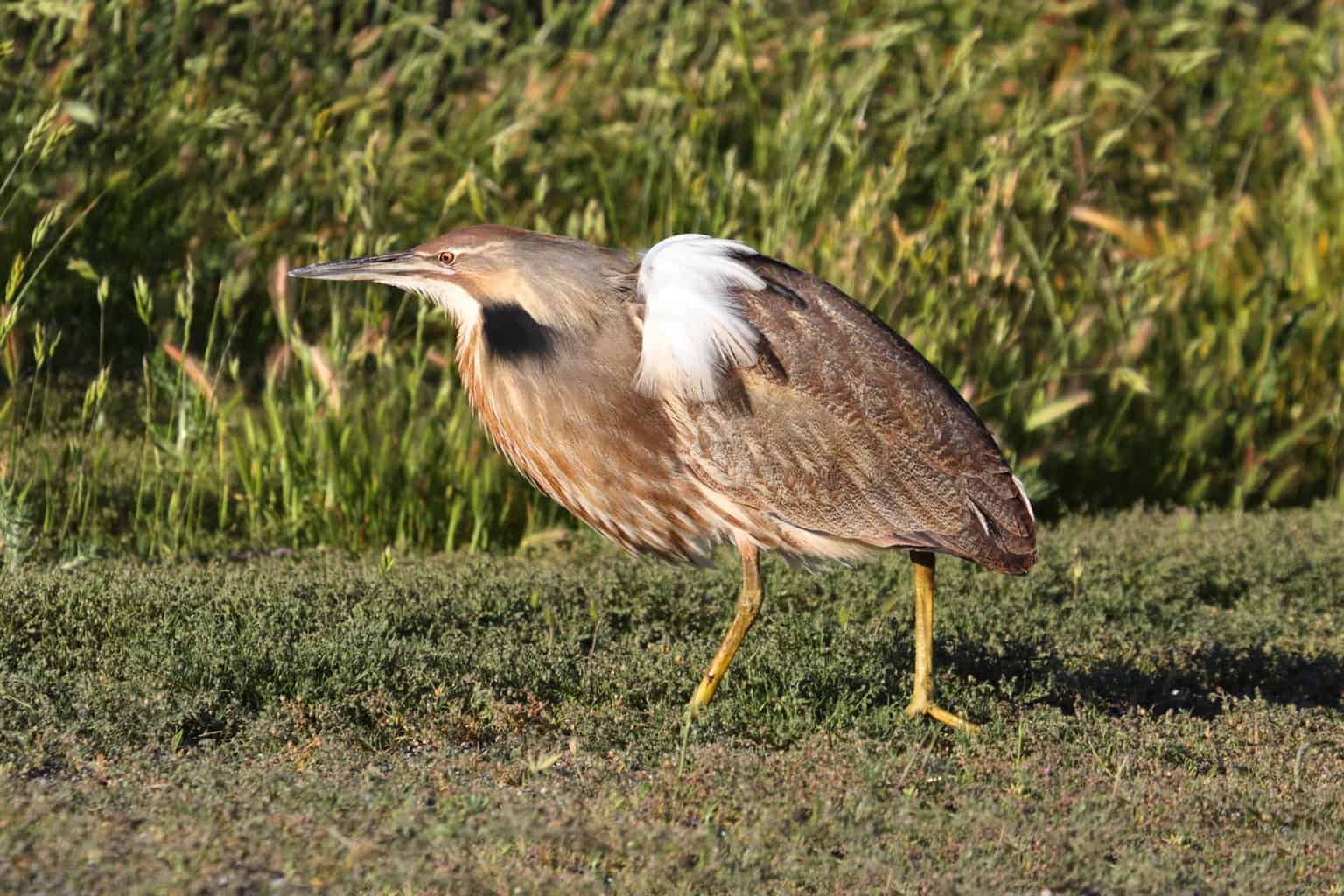
- Length: 23-34 inches
- Weight: 1.3 pounds
- Wingspan: 3 feet
Appearance: The American Bittern has shorter legs than the Great Blue Heron, and its body is more compact, with shorter legs and a much shorter, thicker neck.
Like a heron, their bill is straight and sharp. Bitterns are brown, off-white, and white, with lots of streaking all over their bodies. These unusual bird species have a white stork and pink plumage on their body.
They have a lot of streaking running down their necks. When they stretch out to fly, you can see more of a resemblance to the Great Blue Herons that they are related to because they have a similar silhouette, even with a shorter neck.
Where they live: American Bitterns live in marshes and wetlands. They hide in the tall grass and are hard to spot! They’re migratory birds and like living in shallow waters.
They live throughout North America, but you will only find them in the northern half of the US and Canada during their breeding season. They migrate through the south and spend winters in Mexico.
America White Ibis
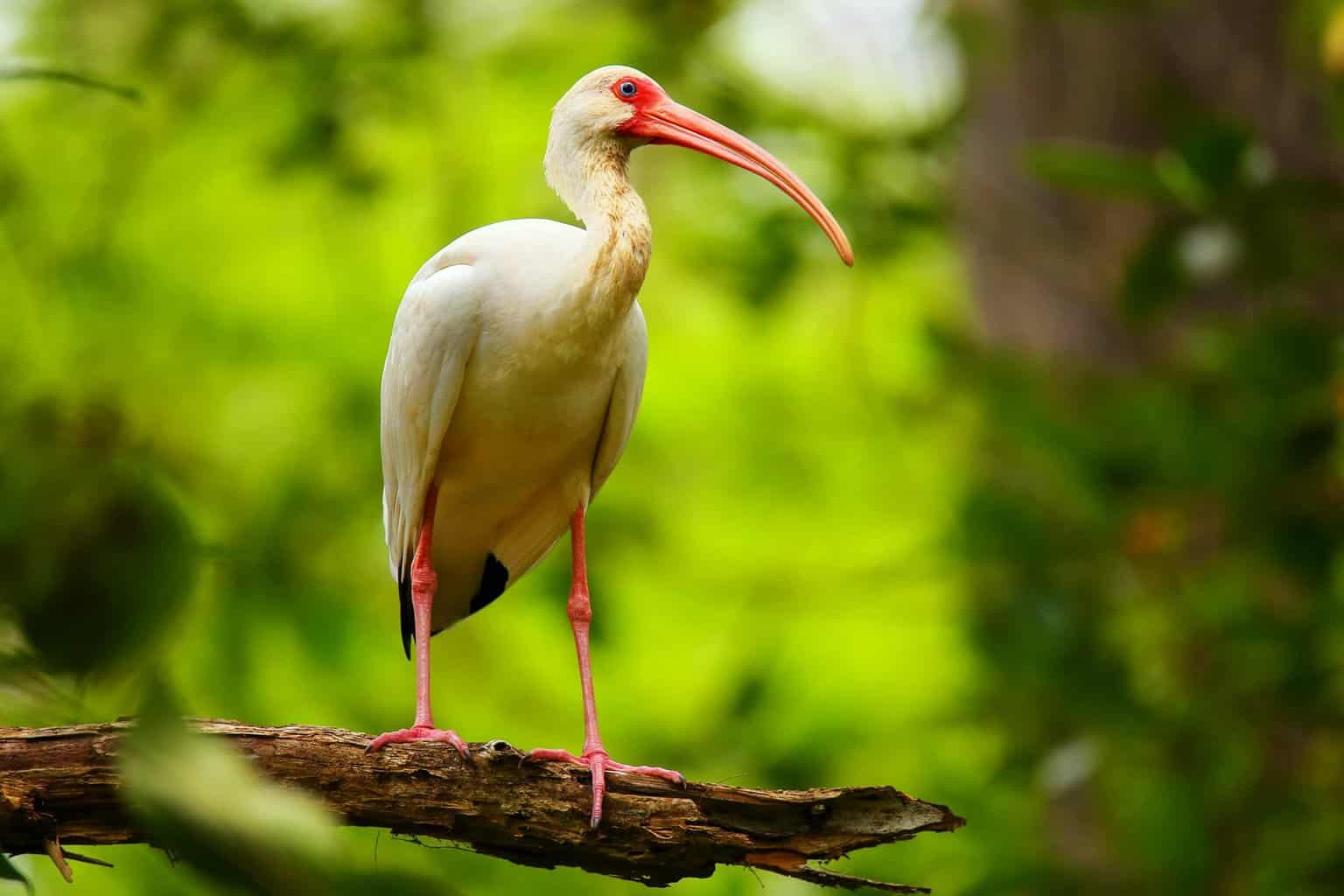
- Length: 21-28 inches
- Weight: 2.1 pounds
- Wingspan: 35-41 inches
Appearance: White Ibises are long-legged, like the Great Blue Heron. They also have long necks. One of the biggest differences between an ibis and a heron is that the ibis’s bill will be curved instead of sharp and dagger-shaped.
They also have webbed feet that they use in the freshwater wetlands and a curved beak.
The American White Ibis has only a little black on its body: right on the tips of its wings. Its legs and bill are both pink, as is its eyering.
Where they live: These birds only live in the coastal wetlands of North America. You can find them along the Atlantic, Pacific, East Asia, and Gulf Coasts. They live in colonies and can be seen wading in the water, walking around in parks, and flying low to catch more prey.
Black Heron
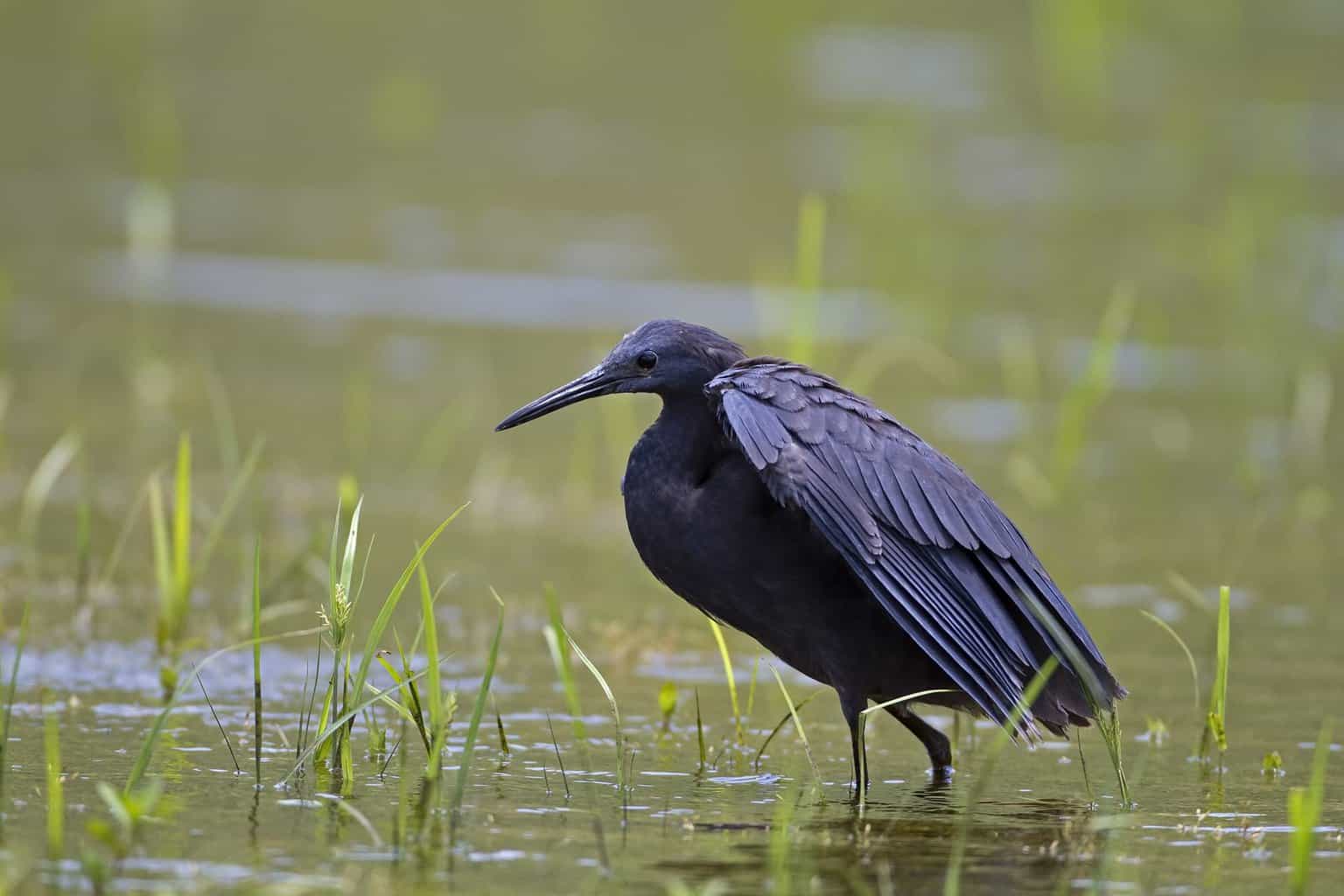
- Length: 16.7-25.9 inches
- Weight: 0.59-0.85 pounds
- Wingspan: 35.4-37.4 inches
Appearance: The Black Heron looks black in dim light and dark gray in the sun. They have black legs and bills, but their feet are yellow. Black Herons are also recognizable by their interesting way of feeding, called the “umbrella technique.”
A Black Heron will spread its broad wings and curl them into an umbrella shape. Then, it will tuck its head under its wings and look into the water to find food. These black-bellied whistling ducks have black wings.
Where they live: Black Herons are more likely to be found in freshwater than along saltwater coasts. They are found throughout Subsaharan Africa, especially along the east coast. Some can also be found in Western Europe and some in Eastern Asia.
Brown Pelican

- Length: About 48 inches
- Weight: 4-11 pounds
- Wingspan: 6-7 feet
Appearance: It’s hard to mistake a Brown Pelican for any other bird. These are huge impressive birds with long bills and a throat pouch that stretches out wide enough to scoop up tons of water as they catch fish.
An adult Brown Pelican will have a yellow head and a brown body. These mottled ducks also have head plumes and white head feathers with distinctive shovel-shaped beaks.
The Brown Pelican’s white neck is thin compared to its thick body. These birds glide through the air, over the water, often in small groups. In flight, their wings are often bent.
These birds have pointy beaks and prefer living in different kinds of wetlands, especially in coastal habitats. These water invertebrates have a range of habitats depending on the size birds.
Where they live: Brown Pelicans live along the southeast and southern coastlines of the United States. That includes the Pacific Ocean, the Gulf of Mexico, and the southern coast of the Atlantic Ocean. They can also be found in some parts of Central Europe.
Grey Heron

- Length: 40 inches
- Weight: 2.4-4 pounds
- Wingspan: 61-77 inches
Appearance: Grey Herons look similar to Great Blue Herons but live in very different parts of the world. Additionally, they don’t have the Blue Heron’s visible brown flanks. Grey Herons also have black underwings, which are visible whether they are standing or flying.
Where they live: Grey Herons live throughout much of the world, including all of Europe, much of Asia, and both Subsaharan and coastal Africa.
These fascinating birds live along the edges of many bodies of water, including seacoasts, rivers, ponds, lakes, marshes, and wetlands.
Great Egret
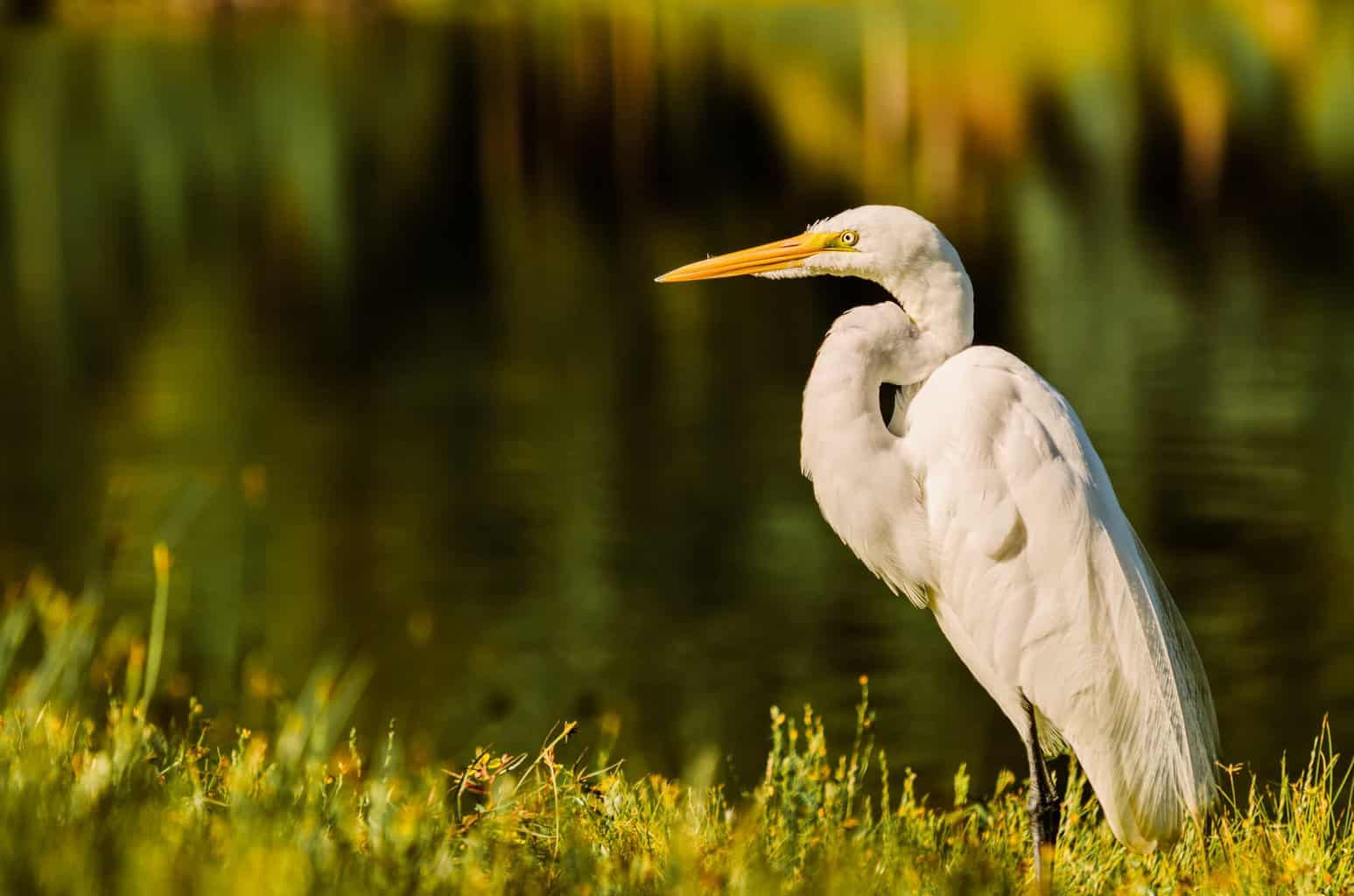
- Height: 36 inches
- Weight: 1.5-3.3 pounds
- Wingspan: 52-67 inches
Appearance: Great Egrets are all-white, with large wingspans. They have many things in common with Great Blue Herons, including their s-shaped neck, long legs, and sharp, pointed yellow bill.
They are slightly smaller than the Great Blue Heron and don’t have that scruffy look. These birds are beautiful and iconic. In fact, the Audubon Society uses the Great Egret in flight as its symbol.
The Audubon Society was an early advocate for laws that protected endangered birds, and the Great Egret was one of the first birds brought back from being threatened.
Where they live: Great Egrets live across much of North America. They are capable of thriving in both freshwater and saltwater environments, and they typically nest in large colonies of other Egrets.
These social birds stay safe from predators by building stick nests in the treetops. They will even live on islands to avoid predators like raccoons and coyotes. These white-colored wading birds resemble herons in appearance.
They live in South America for the entire year and can be found in most North America during other parts of the year.
Little Blue Heron
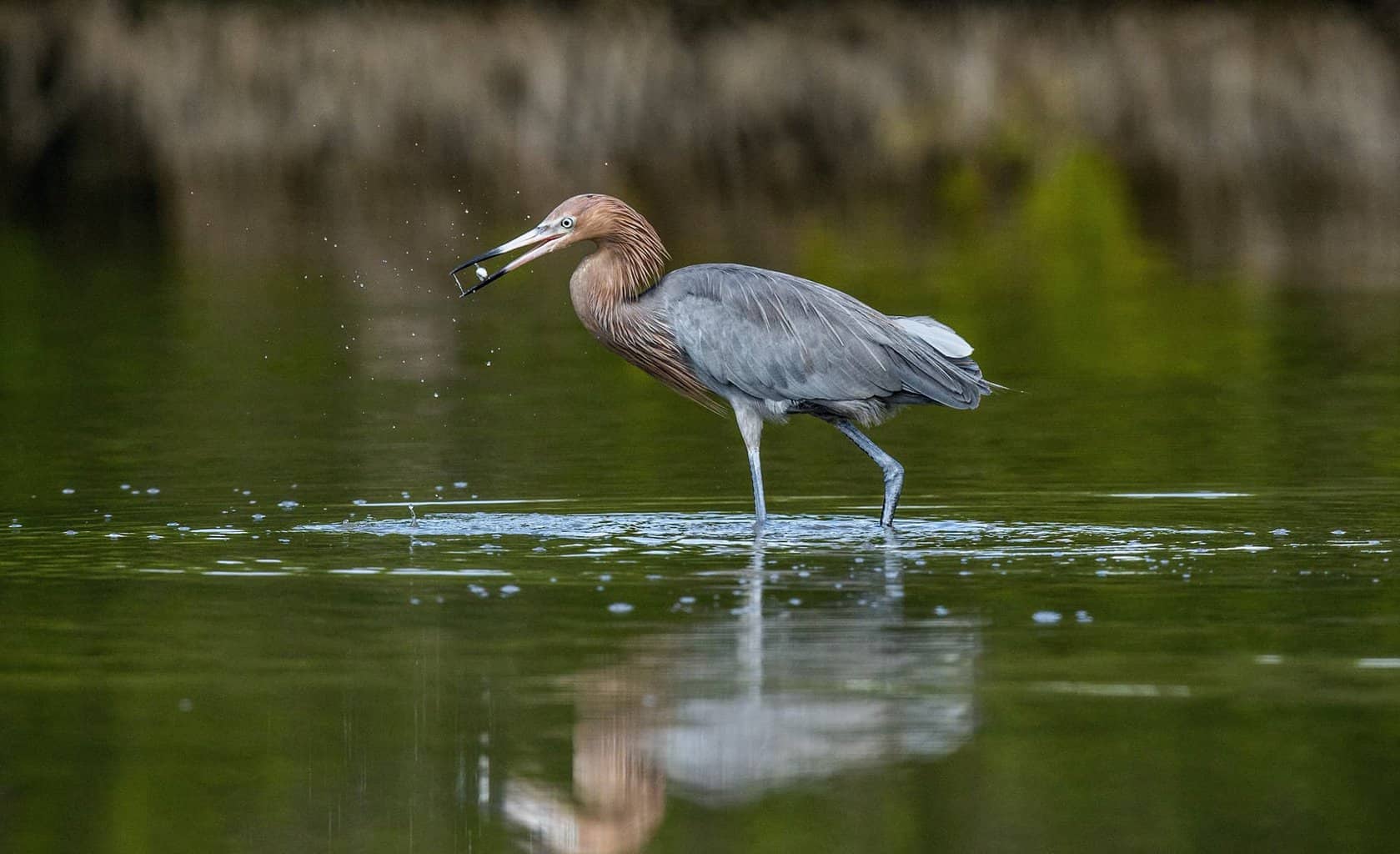
- Length: 22-29 inches
- Weight: 14.0 ounces
- Wingspan: 39-41 inches
Appearance: The Little Blue Heron is much darker in color than the Great Blue Heron, which is more grayish-blue.
It is also significantly smaller. As young birds, they are all white–and then slowly transition being dark blue and purple.
The bill of a Little Blue Heron changes from blue at the base to black at the tip. Like other herons, the Little Blue Heron has a pointed, dagger-shaped bill. Unlike other herons, its legs are green. They prefer living in massive waters.
Where they live: Little Blue Herons live in small communities, not large colonies. They prefer still water over rushing rivers or active seacoast. Their range the American Southeast, southern Mexico, and some areas in northern South America.
Pacific Reef Heron
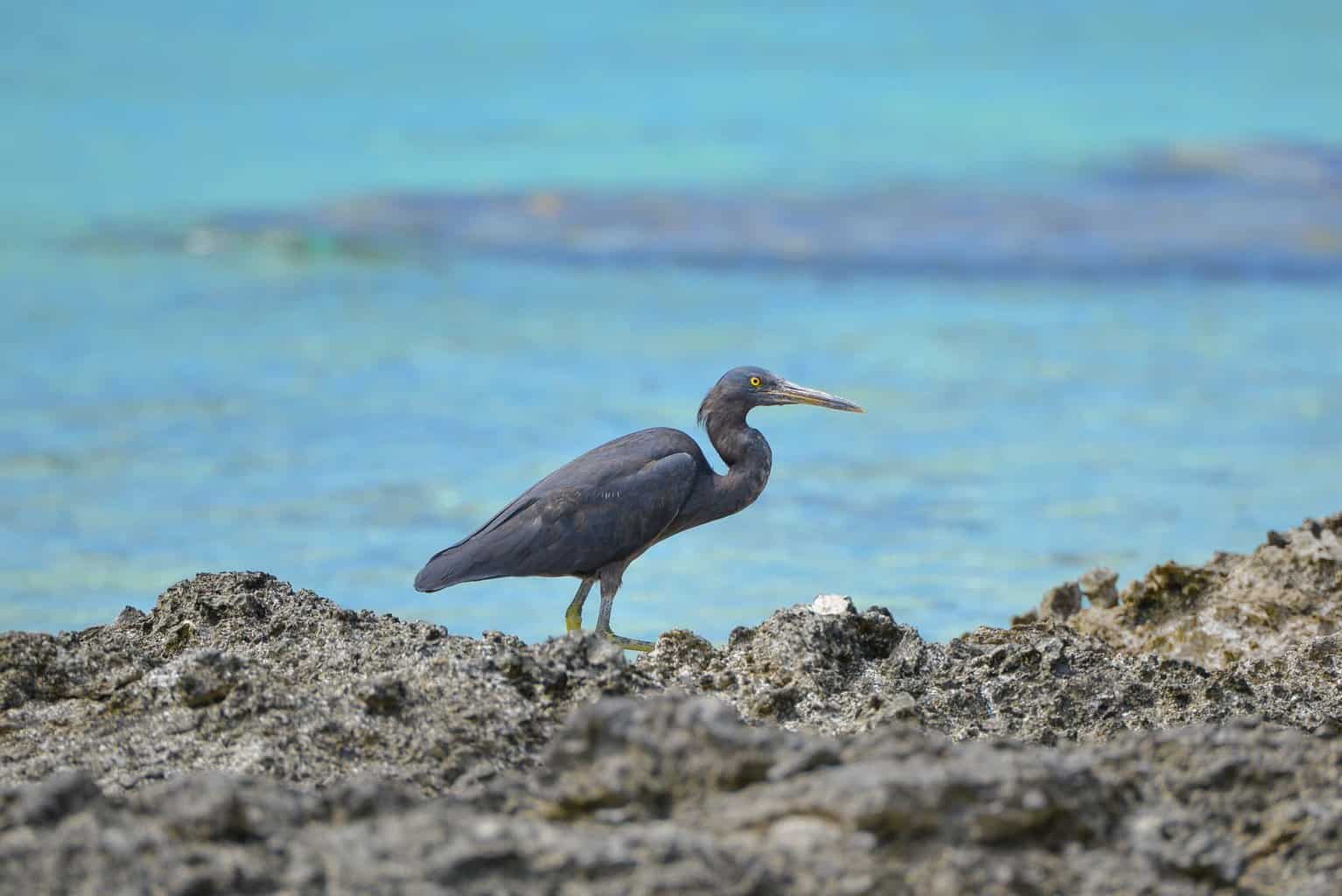
- Length: 22.4-25.9 inches
- Weight: About 14 ounces
- Wingspan: 35.4-43.3 inches
Appearance: The Pacific Reef Heron’s appearance varies from morph to morph. These variations are an example of non-sexual dimorphism. Instead of the bird’s sex being the basis for its appearance, how it looks is determined by which morph it is part of.
A dark-morph Pacific Reef Heron is dark gray, almost black. A light morph, on the other hand, is almost entirely white.
Dark and light morphs have a greenish-yellow bill and legs. Watch the legs and bill when differentiating between a Pacific Reef Heron and the egrets that share their territory. Pacific Reef Herons have shorter legs and a bill that is much thicker.
Where they live: Pacific Reef Herons live throughout South Asia and Oceania. They are common in Micronesia but have also been spotted in Guam, the Marshall Islands, and other Pacific islands. The farthest south they go is in Northland, New Zealand.
They inhabit coastlines and islands, staying close to the water where they get their food.
Reddish Egret
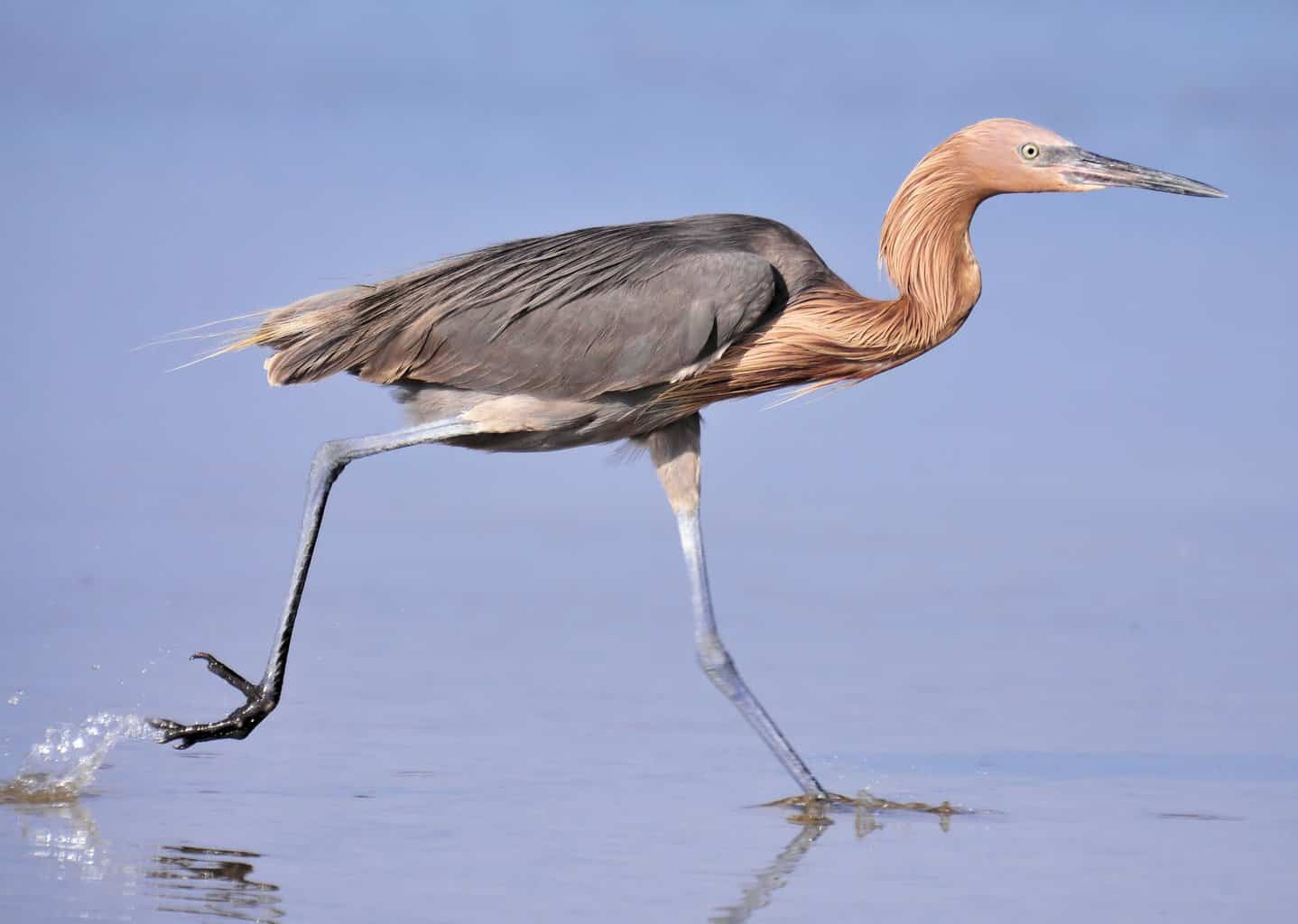
- Length: 27-32 inches
- Weight: 1.4 pounds
- Wingspan: 46-49 inches
Appearance: The Reddish Egret is another non-sexually dimorphic species. The most common version is a dark morph with a dark grayish-blue body and a rosy pink head and neck. A less common version is the white morph, which is snowy white all over.
Juveniles are the only egrets that are coppery-brown.
Reddish Egrets have the familiar signs of other egrets: long legs, long necks, and sharp, thick bills.
Where they live: Reddish Egrets prefer salt flats and lagoons. They live in the keys, mangrove forests, or on barrier islands off the coast.
They live along the coast of the Gulf of Mexico, along the Pacific Coast in Mexico, and Cuba, Puerto Rico, Haiti, and the Dominican Republic.
Roseate Spoonbill

- Length: 28-34 inches
- Weight: 42-64 ounces
- Wingspan: 47-51 inches
Appearance: The Roseate Spoonbill may be the most flamboyant and dramatic bird on this list! At first glance, their silhouette may be reminiscent of a Great Blue Heron. But these are very different birds!
Roseate Spoonbills are Pelecaniformes, but they are not part of the Ardeidae family. They are bright pink, with red eyes and a huge bill shaped like a spoon. They use their spoonbills to scoop fish and crustaceans out of the water.
They have long legs, thick feet, and a body shape like a football.
Where they live: Roseate Spoonbills may be migratory or year-round residents. They don’t go far, though; Roseate Spoonbills are only found along the coasts of the Pacific Ocean in Mexico, the Gulf of Mexico, and Central America, as well as parts of South America. Much–but not all–of Brazil is home to Roseate Spoonbills.
Snowy Egret

- Length: 22.1-26 inches
- Weight: 13.1 ounces
- Wingspan: 39.4 inches
Appearance: Snowy Egrets get their name from their beautiful, snow-white plumage. They have long black legs, bright yellow feet, and a sharp black bill that is yellow at the base.
They also have a yellow band from their eyes to their bill. Otherwise, they are all white, no matter their sex.
Snow Egrets also have an all-white plume on their heads and backs. This once made them the target of egret hunters because the plume could be used in the fashion industry, especially in hats. Fortunately, conservationists were able to fight to protect these gorgeous birds.
Where they live: Snowy Egrets live year-round in most of South America, except the Andes Mountains. Their migration and breeding territory includes Mexico and much of the United States.
They can get food from salt and freshwater sources, so they aren’t limited to living along the coastline.
Tricolored Heron
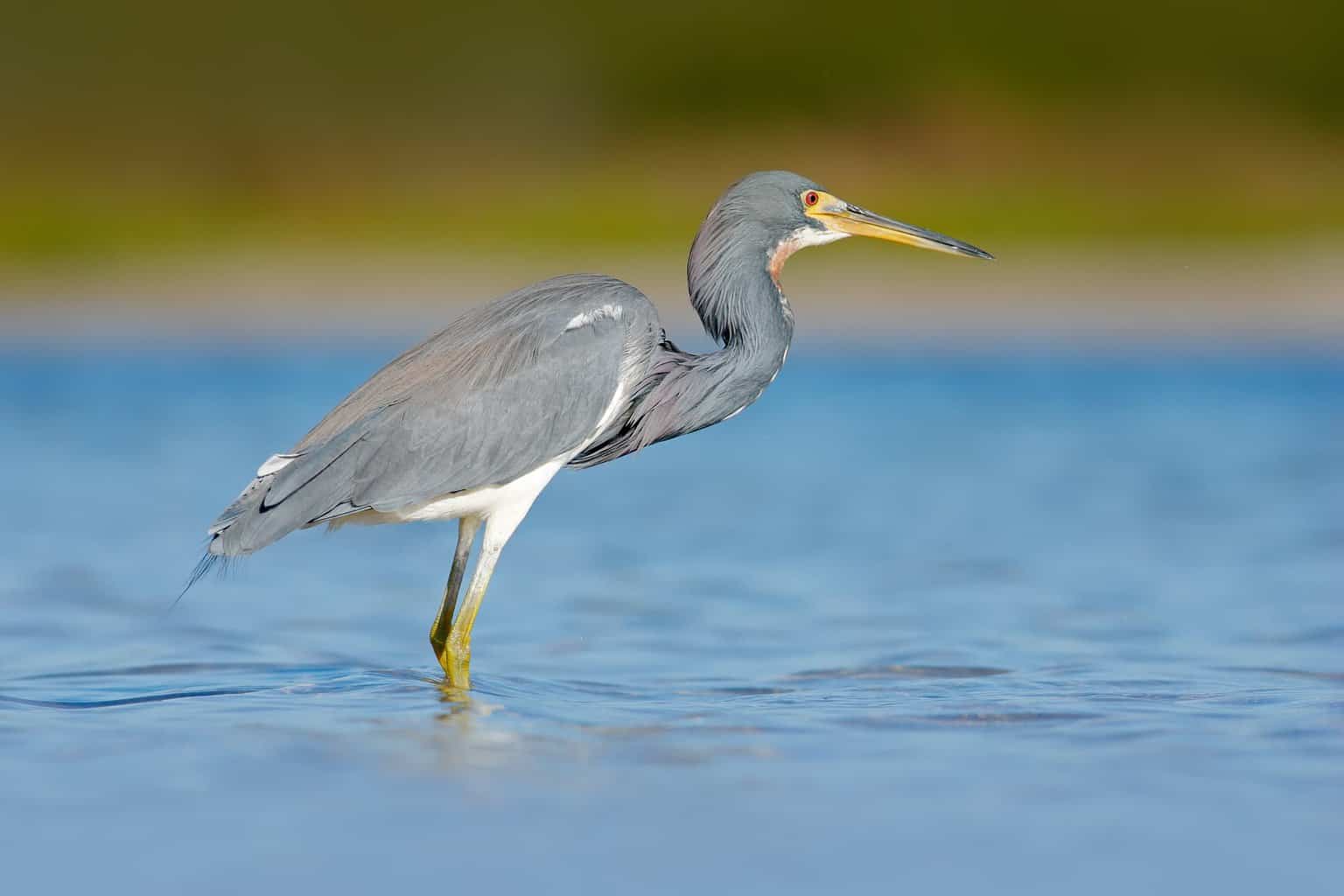
- Length: 22-30 inches
- Weight: 14.6 ounces
- Wingspan: 37.4 inches
Appearance: Tricolored Herons are unique compared to dark-colored herons, as they have an all-white belly. The rest of their body is blueish-gray and purple, although juvenile birds also have rust-red feathers.
The shape of the Tricolored Heron is comparable to the Great Blue Heron: long legs, slender neck that can be held in an s-shape, and sharp bill.
Where they live: Like most other herons, Tricolored Herons live along the waters. They can be found in mangrove forests and lagoons, saltmarshes and estuaries, and along the edges of lakes, canals, ditches, and coasts.
Their territory extends north into the United States; they can be found as far north as Massachusetts. They also live along the Gulf, Atlantic, and Pacific Coasts.

